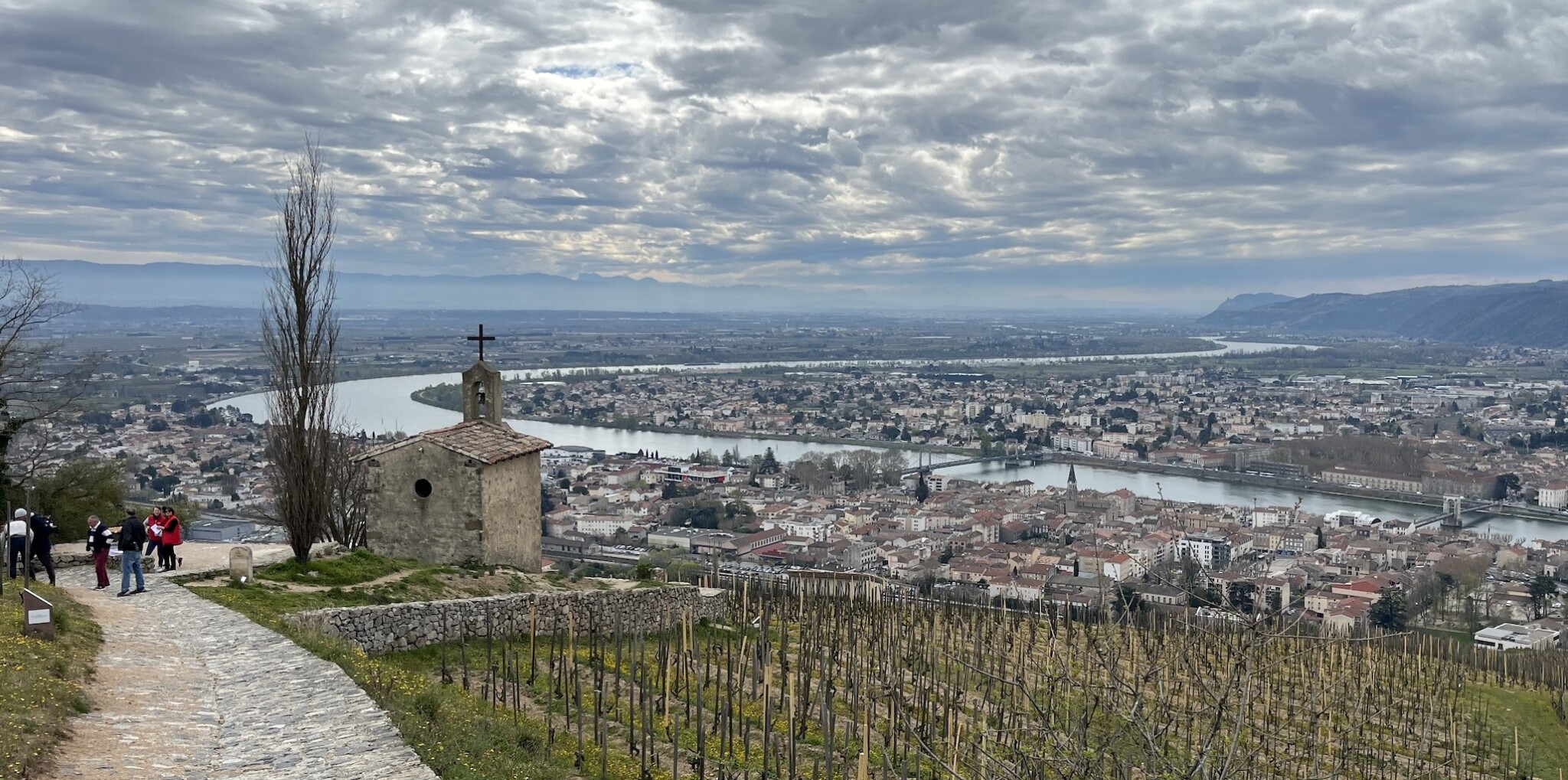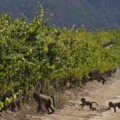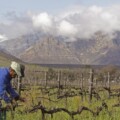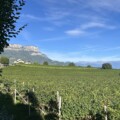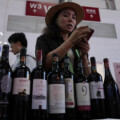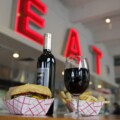The catalogue from the Halpern agency’s recent portfolio tasting in Toronto lists the Paul Jaboulet Aîné Domaine de la Chapelle 2022 La Chapelle at $485.59 a bottle. It was the first red that I tasted when I attended the event. I was eager to try it because I had been standing in that vineyard, looking over the Rhône River Valley just weeks before.
It tasted pretty good. It’s made, like all the serious red wines from the upper reaches of the Rhône River, from 100 percent Syrah. The Syrah (aka Shiraz) grape can often go to black fruit flavours, but this one hovered more into red fruits, like raspberry, and a touch of liquorice and leather. The mouthful I had resonated long after I had swallowed it, and I was pleased to have caught a glimpse of this still very young wine.
I traveled to France on a press trip at the beginning of April as guest of Inter-Rhône, the “interprofessional” organization that supports and promotes its members who make wine and own the lands along the main run of the Rhône River, from roughly Lyon to the Mediterranean Sea. Half my time was spent in Avignon tasting and meeting the makers of blended wines like Côtes-du-Rhône. The other half was spent upriver in Tain and Mercurol, at the foot of the Hermitage hill, and Condrieu, Ampuis and Vienne. In this area the wines are either made with a single variety of grape (Syrah or Viognier) or a blend of just two (Marsanne and Roussanne).
The Northern Rhône is formally called the Septrentonial Rhône, so called for the seven stars of the Ursa Major, the Big Dipper. You can certainly see the Big Dipper from the Northern Rhône, but looking at a map, the hills that grow its wine are not that far north in France. If the climate in the Northern Rhône isn’t all that much different from the South, the soils are: granite takes over from limestone. And so is the style.
Wine is a subject for which it is extremely dangerous to generalize. For every rule there is at least one, if not many exceptions. I’ll give one anyway. When I think of the difference between the two Rhône styles, I think of the Southern wines being served at a dinner party of good friends, and the Northern Rhône wines served on a date at a fancy restaurant.
The Northern Rhône is close to Lyon, held by many (not least the Lyonnaise) as the gastronomic capital of France. Wines like Hermitage, Cornas, and Côte-Rotie must compete on lists with the other local wines to the north of the city: Beaujolais and Burgundy. The traditional competition for Northern Rhône Syrah, would have been less Southern Rhône Grenache based blends than Pinot Noir.
The Northern Rhône, like the greater valley, is also split between a northern and southern area. Just south of the old Roman capital of Gaul, Vienne, in the “Northern North” are the twin appellations of Côte-Rotie and Condrieu, on the right (western) bank of the river. Here solitary vines are trained on poles in narrow terraces cut out of slopes as steep as 60 degrees. Nearly everything is done by hand; there’s no room for machinery.
There are only around 60 wine-making estates on the Côte-Rotie, with another 40 or 50 growing grapes for them. Those grapes are mostly Syrah, with some Viognier. Most Viognier is grown in the comparably small-sized neighbouring white wine region of Condrieu, which occupies the steep slopes to the south. Each has only about 200 hectares (just under 500 acres) under vine.
Production for both Côte-Rotie and Condrieu is small, and many domaines make high-priced wine from both. As the slopes of Condrieu run south along the west bank of the Rhône, it bleeds into St. Joseph, so a domaine might make a Condrieu from Viognier and a red St. Joseph from Syrah. Just to confuse things further, they might also make a white St. Joseph from Marsanne and Roussanne.
The good news is the quality of St. Joseph now rivals Côte-Rotie. The bad news is the prices are catching up to reputation, as they always seemed to. The long St. Joseph appellation trails along the right bank of the river until it ends opposite the town of Tain, which sits at the bottom of the Hermitage hill and the small chapel on top of it.
The bad news about the Hermitage appellation is that it is confined to one not very big hill on the east side of the Rhône. There will never be more Hermitage than there is, and as demand rises but supply remains static, prices will surely rise. The good news is the quality of the wines made in the smaller hills and river plains that surround it in Crozes-Hermitage are also rising and don’t cost a king’s ransom yet.
Crozes-Hermitage is just where value lives in the Northern Rhône, it’s where some of the most interesting wines I tasted are made. Once an appellation becomes a luxury brand, its winemakers have a tendency to become conservative. At a special tasting and barbecue held by a group of young winemakers near the town of Mercurol,
I tasted a full spectrum of Crozes-Hermitage Syrah from juicy and easy going to reserved and elegant.
Finally, further south of the Hermitage, and back on the right bank of the river, is the third contender for the Northern Rhône’s premier appellation, Cornas. Cornas is always red. It gets points for often being a dark and rich wine, but also for being a fun, slightly irreverent one. It shows the generous side of Syrah’s black fruit, violets and spice side.
If the Northern Rhône makes date night wines, then it’s St. Joseph and Crozes-Hermitage at the bistro. If it’s a special occasion meal, and the reservation was made well in advance, then it’s Condrieu to start, and you’ll have to negotiate the choice of Hermitage, Cornas or Côte-Rotie…possibly with your banker, but the wine will be good.
